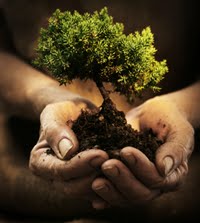I think most of us understand that we should be watering newly planted trees and shrubs in this heat… When talking to our tree experts, though, I was surprised to hear what they defined as "newly planted". Trees and shrubs that were planted in the last 2 years really need supplemental water to avoid decline in these continued high temperatures. That's right. It takes 2 growing seasons before most trees and shrubs are considered established. So how much is enough?
There are equations that tell us exactly how much water you need to replace what is lost through the leaves of the plant on a hot, windy day.
- Multiply inches of evapotranspiration (you can get this from the weather service) by the square footage inside the drip line of your tree. Then multiply that by 0.62 (gallons in an inch of water) to estimate the gallons of water used by the plant. evapotranspiration x sq ft x 0.62 = water loss per day
Basically, you want to insure that you are watering to the bottom of the root ball without overwatering. If you insert a metal rod into the soil ball and are unable to push it more than a couple of inches, you need to water more. Water slower, for a longer period to reach those deeper roots and to allow the water to soak into the soil/root ball instead of just running off around it. With this method, you should be able to water every 10 to 14 days. Just keep in mind, even if you have drip irrigation set up, it may not be enough with the extreme temperatures we've had recently in the Charlotte area. (12 days of over 100 degree temperatures!)
So keep up the watering. The first couple of growing season are CRUCIAL for the health of the plant.
Thanks,
The AA Tex Lawn Team

